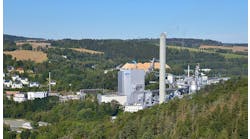From the Editors of CONTROL
In an attempt to take better care of operators and ultimately improve process efficiency, Worsley management challenged its process control group with this task: Create an environment where process operators can perform optimally.
To meet the challenge, Worsley developed the Advanced Process Management concept, which included a centralized control room, better alarm management, new simulation facilities and implementation of advanced process control strategies. The project was implemented by an integrated team of Honeywell, Worsley and design consultants.
Good alarm management means a better operator environment, Oliver said. After alarm system optimization and rationalization and the installation of new, redesigned graphics, he explained, alarms dropped in one area alone from 129 alarms a hour to 11.
“We revisited alarm limits, and we decided that if we did not need a direct action, we did not need an alarm,” said Oliver. “We also implemented smart alarming: We now allow shelving, first-out alarming, mode-dependant and offline suppression.”
To consolidate improvements in alarm rates, Worsley has appointed “alarm custodians” who are responsible for identifying the 10 most critical alarms each day and seeing to it that the issues so flagged are addressed.
Moving to a centralized control room with a theater-style picture wall of information screens with simplified graphics provided another improvement. This part of the installation required study of ergonomics and the way humans function and process information—and consultation with the operators, said Oliver.
“Now we’ve adopted the ASM [Abnormal Situation Management] style, trained our operators and left them alone to design their own screens. We’ve been pleasantly surprised at what they did,” he said.
Besides operator concerns, questions such as screen size and height in relationship to operator location and the height and style of text on the screens were considered. So was color. Worsley made the decision to use color on screens only for alarms to make it easier for operators to evaluate alarm events quickly.
The video wall mimics the flow of product. Adjacencies were sorted by the special needs of people to communicate, explained Oliver. One of the goals of the upgrade was to encourage collaboration and team work. “The goal of the big screen is to get operators to see when things are going wrong and act; then just sit back and watch the process,” said Oliver.
The control room does not have direct lighting, and each operator has control over the lighting in his area. Workstations are adjustable so the top of the display can always fall at the individual operator’s eye level.
To help operators stay focused on the job at hand, they also are provided with a separate screen for email, which is located behind them. They turn away from the process, check email and turn back; the theory being that by changing position, they are aware that they have taken their eyes off the main screens and return more quickly.
Because operators work 12-hour shifts, there is a kitchen and exercise area directly adjacent to the control room.
The wall opposite the video wall is glass, so that management and others can also view operations, particularly in the event of an emergency. “We’ve provided a conference room that can easily be converted into a war room in the event of problems,” said Oliver.
These kinds of improvements don’t come cheap. The justification of such a project to senior management requires “small words and short sentences,” said Oliver. For example, “Optimization means money.”
In this case, he added, “We had to explain maximum process capacity to our management. Operators are conservative and always adjust the setpoint lower than maximum capacity. If we can find a way to set the setpoint closer to the maximum process capacity, the difference is money. The management loved that explanation. So we got approval to implement advanced process control on spent liquor and increased efficiency by three times, saving a huge amount of money. We also reduced by 80% the number of moves the operator has to do every day—an unexpected freebie.” Another freebie was in multi-variable control of the plant’s fine-seed process. “There have been only three events leading to a change in pump seals, with huge cost savings.”
Oliver wrapped up with a video demonstration of the work of the optimized operator reacting to an urgent alarm situation.
To enjoy the 30-second clip he showed, CLICK HERE.




